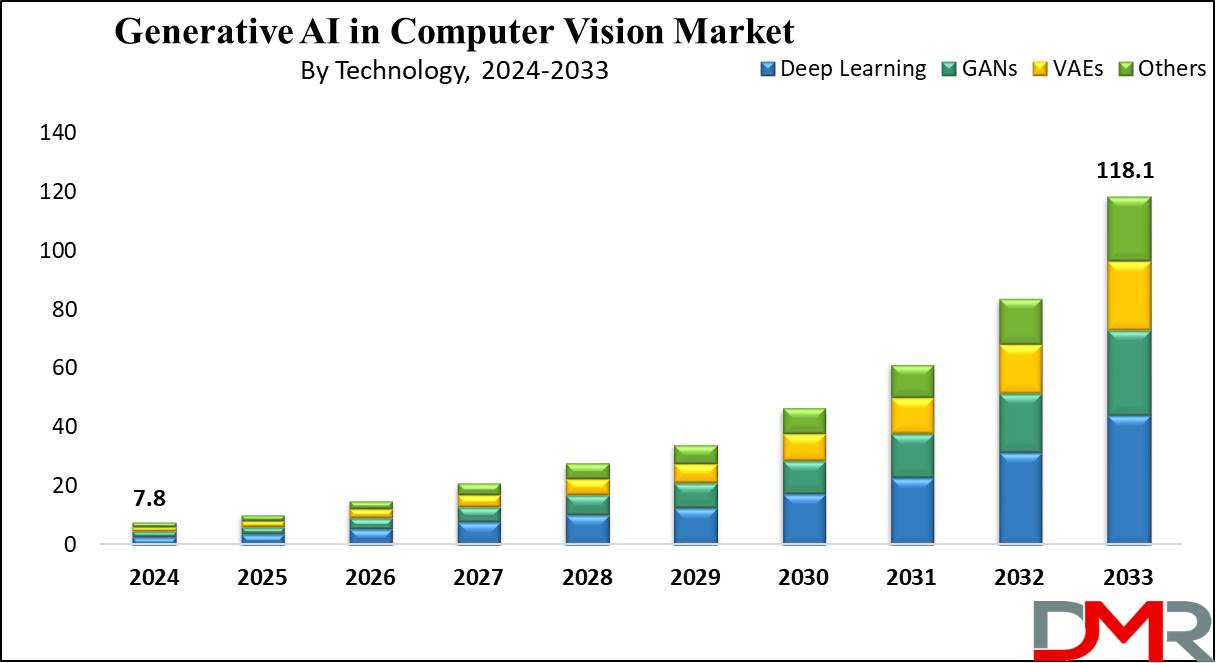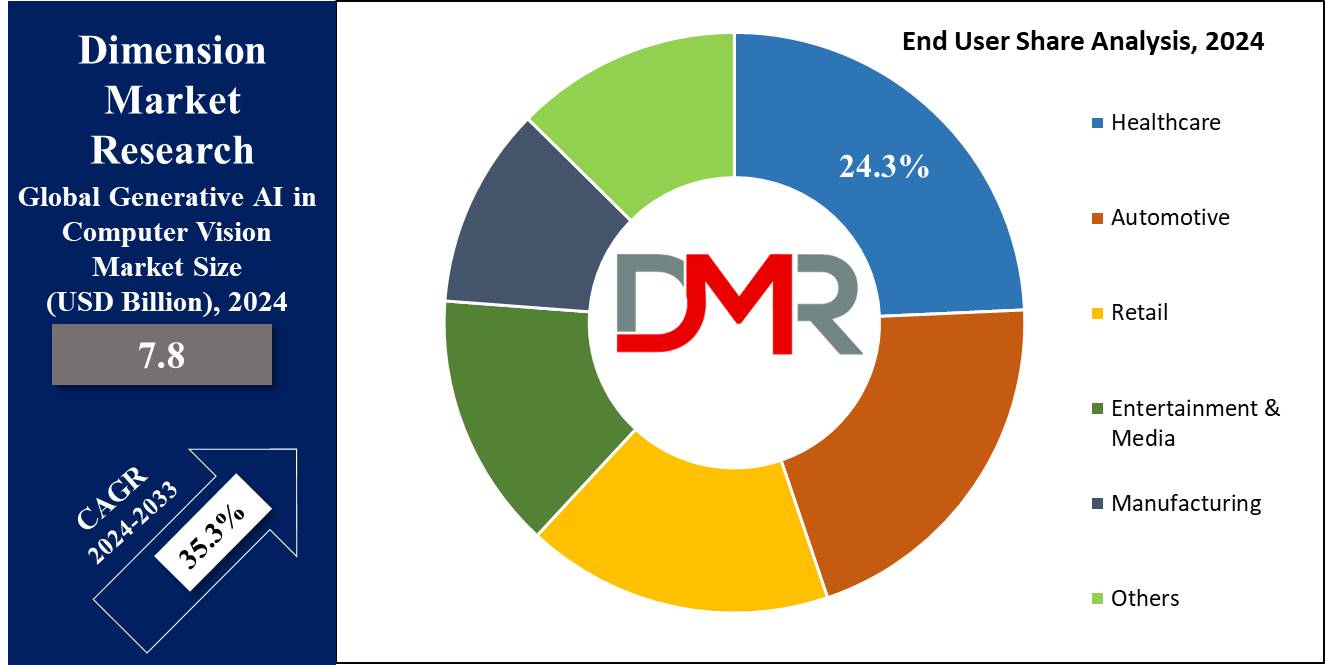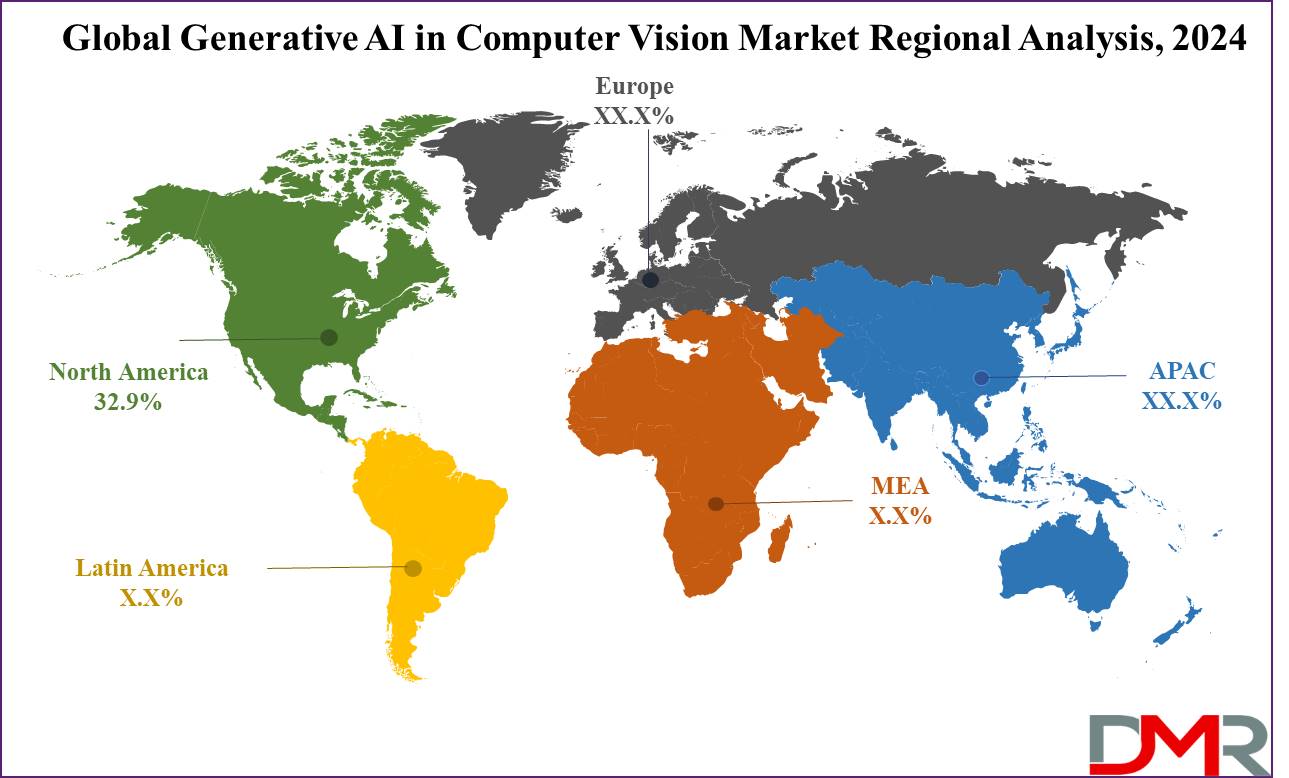Market Overview
The Global Generative AI in Computer Vision Market is expected to reach a value of USD 7.8 billion by the end of 2024, and it is further anticipated to reach a market value of USD 118.1 billion by 2033 at a CAGR of 35.3%.
Computer vision plays a major role in image processing by allowing machines & computers to understand visual information. It automates tasks that depend on human vision, enhancing accuracy. Computer vision systems can achieve up to 99% precision, excelling human capabilities. Integration with generative AI merges computer science & engineering, enabling industries to streamline processes & minimize the need for manual intervention, enhancing efficiency.

With the rapid pace of global digital transformation,
Artificial Intelligence (AI) is widely adopted across industries. In particular, AI-powered computer vision systems enable machines to extract meaningful insights from digital images, videos, and other visual inputs, facilitating informed decisions and actions. These AI-powered visual recognition solutions support automated analytics in diverse domains, from manufacturing to healthcare.
This technology heavily relies on AI and
machine learning to automate and integrate processes related to visual data interpretation. Key methodologies include image processing encompassing encoding, transformation, and transmission and statistical pattern classification.
The global Generative AI in Computer Vision Market is poised for substantial growth. Factors such as rising demand for computer vision in automotive applications, increasing interest in emotion AI, and growing need for quality inspection and
Industrial Automation are fueling expansion. Additionally, government initiatives to accelerate advancements in AI-driven vision systems create significant opportunities, further propelling the industry forward.
Key Takeaways
- The Global Generative AI in Computer Vision Market is expected to grow by 110.3 billion, at a CAGR of 35.3% during the forecasted period.
- By Technology, Deep Learning segment is expected to lead in 2024 & is anticipated to dominate throughout the forecasted period.
- By Application, Content Creation & Enhancement segment is expected to have a lead throughout the forecasted period.
- By End User, Healthcare sector is expected to be the dominant driver of the growth of the market in forecasted years.
- North America is expected to hold a 32.9% share of revenue in the Global Generative AI in Computer Vision in 2024.
- Some of the use cases of Generative AI in Computer Vision include anomaly detection, data augmentation, and more.
Use Cases
- Image Super-Resolution: Generative adversarial networks (GANs) & other generative models can be used to improve the resolution of images. Low-resolution images can be used in these models, which then generate high-resolution versions with added details, which have applications in medical imaging, satellite imaging, surveillance, & enhancing old photographs.
- Image-to-Image Translation: Generative models can translate images from one domain to another while preserving semantic content. Like, as converting images from day to night, changing the season in landscapes, or transforming sketches into realistic images, which find applications in the entertainment industry, urban planning, virtual fitting rooms, and more.
- Data Augmentation: Generative models can be utilized in creating synthetic data that looks like real data, which is mainly useful for training computer vision models. Generating variations of existing datasets helps to overcome limitations like data scarcity and bias, which are majorly used in autonomous driving, object detection, & facial recognition systems.
- Anomaly Detection: It can learn the distribution of normal data &identify anomalies that vary significantly from it. By training on a dataset containing only normal instances, the model can create synthetic cases of what it considers normal. Any deviation from these generated samples can then be flagged as an anomaly, which is valuable in applications like quality control in manufacturing, detecting defects in products, & identifying anomalies in medical imaging.
Market Dynamic
The need for automated quality control in manufacturing expands the growth of Generative AI in Computer Vision. Traditional manual inspection, with error rates of 20-30%, cannot match AI systems’ precision. Generative AI develops synthetic datasets, reducing the need for large labeled datasets and improving defect detection efficiency. This reshapes manufacturing quality control, further enhanced by GANs & diffusion models, boosting Deep Learning accuracy by 30-40%.
However, using generative models, mainly in sensitive areas like medical imaging, raises privacy concerns. Techniques such as GANs & VAEs need significant computational resources & labeled datasets, creating challenges for smaller firms with limited budgets. The high cost of training models limits access & slows down innovation in the field, building barriers for smaller players in the market.
Driving Factors
Generative AI adoption in computer vision solutions has been driven by demand for enhanced image and video analysis. Companies from industries as diverse as healthcare, automotive, retail, and aerospace rely on Generative AI powered solutions for facial recognition, object detection and anomaly detection applications such as facial recognition.
Generative AI helps businesses improve accuracy, automate complex tasks and gain real time insights which make it invaluable in industries reliant on visual data processing this growth is further reinforced by personalized customer experiences as well as robust surveillance systems.
Trending Factors
Integrating Generative AI and edge computing is an emerging trend in computer vision market, providing AI powered visual analysis locally on devices, reducing latency and improving real time decision making. Applications that combine Generative AI with edge computing such as autonomous vehicles, smart manufacturing, IoT etc benefit greatly from edge based Generative AI applications which eliminate latency by performing visual analysis locally on devices reducing latency.
While improving real time decision making this trend addresses privacy concerns by minimizing data transfer into cloud systems minimizing data transference into cloud systems while edge computing technologies will undoubtedly change how computer vision applications operate offering faster, safer, more secure yet efficient solutions in future years to come!
Restraining Factors
Generative AI implementation in computer vision presents unique difficulties due to its high computational power and costs. Training AI models requires access to costly GPUs and large datasets; which could prove prohibitively expensive for smaller organizations.
Maintaining AI infrastructure also necessitates continuous investments in hardware and software. Finally, deployment Generative AI solutions into existing systems is often complex. To overcome such barriers successfully and achieve wider adoption across industries.
Opportunity
Generative AI computer vision offers enormous potential in healthcare and retail settings. AI powered imaging helps physicians diagnose disease, surgical plan surgeries, monitor patients and create personalized recommendations; while Generative AI enhances customer experiences with virtual try ons, inventory management, personalized recommendations and virtual try ons.
As more industries adopt AI-based visual analysis software, demand for Generative AI grows. It revolutionizes operational workflows, enhances product quality, and drives market growth in high-demand sectors such as
Healthcare Analytics and retail.
Research Scope and Analysis
By Technology
Deep Learning is expected to emerge as the leading technology in the Generative AI in the Computer Vision market in 2024. Its strength depends on processing large datasets, allowing correct image recognition & classification. Convolutional Neural Networks (CNNs) are essential in providing unmatched accuracy in tasks like object detection and segmentation.
Further, Generative Adversarial Networks (GANs) and Variational Autoencoders (VAEs) are also significant. GANs lead in generating realistic images for data augmentation, while VAEs are important for tasks like image reconstruction.
By Application
Content Creation & Enhancement is anticipated to be a leading application segment in Generative AI in Computer Vision in 2024, which is driven by the growth in demand for advanced visual content across many media platforms. Generative AI streamlines content creation by automating and refining image & video generation processes, making them fast and more effective.
Further, applications like Image and Video Synthesis, Image-to-Image Translation, and Style Transfer. Image-to-image translation and Style Transfer stand out for their ability to creatively modify & improve images, benefiting industries such as advertising, film, and gaming. These technologies transform content creation workflows, allowing users to produce captivating visuals efficiently.
By End User
Healthcare is predicted to be the leading industry in the Generative AI in Computer Vision market in 2024. Generative AI revolutionizes diagnostic imaging, expediting the analysis of medical images like X-rays & MRIs with higher accuracy. It also supports medical research by generating complex anatomical models & simulations. In addition, other sectors like Automotive, Retail, Entertainment and Media, and Manufacturing extensively use generative AI.

In automotive, it contributes to advanced driver-assistance systems (ADAS) & autonomous vehicle development. Also, retail sectors benefit from enhanced customer experiences through virtual try-on solutions & personalized marketing strategies. These industries use generative AI to streamline processes, enhance products, and expand customer engagement, highlighting its broad impact across many sectors.
The Generative AI in Computer Vision Market Report is segmented on the basis of the following
By Technology
- Deep Learning
- Generative Adversarial Networks (GANs)
- Variational Autoencoders (VAEs)
- Others
By Application
- Content Creation and Enhancement
- Image and Video Synthesis
- Image-to-Image Translation
- Style Transfer
- Others
By End User
- Healthcare
- Automotive
- Retail
- Entertainment and Media
- Manufacturing
- Others
Regional Analysis
North America is expected to lead the Generative AI in the Computer Vision market in 2024 with a
32.9% share, driven by advanced technology & higher investments in AI research. The US, with its tech giants & startups aiming at AI & computer vision, leads this growth. Further, universities & research institutions in the region contribute to advanced AI developments. Favorable policies & funding initiatives further support innovation.

Moreover, the Asia-Pacific region is experiencing fast market growth due to growth in AI adoption & investments. China & Japan lead in adopting AI in surveillance & manufacturing, highlighting the global potential of AI applications.
By Region
North America
Europe
- Germany
- The U.K.
- France
- Italy
- Russia
- Spain
- Benelux
- Nordic
- Rest of Europe
Asia-Pacific
- China
- Japan
- South Korea
- India
- ANZ
- ASEAN
- Rest of Asia-Pacific
Latin America
- Brazil
- Mexico
- Argentina
- Colombia
- Rest of Latin America
Middle East & Africa
- Saudi Arabia
- UAE
- South Africa
- Israel
- Egypt
- Rest of MEA
Competitive Landscape
The global market for generative AI in computer vision is highly competitive, with many players competing for market share. These companies provide a variety of solutions, like image generation, object detection, and video analysis.
Further, major factors driving competition like technological advancements, ease of integration, & the ability to deliver accurate & reliable results. As the need for computer vision continues to rise across industries, competition in this market is expected to intensify further.
Some of the prominent players in the global Generative AI in Computer Vision Market are
Recent Developments
- In October 2023, Tech Mahindra, launched ‘Vision amplifAIer’ solution under TechM amplifAI suit of AI offerings & solutions. The solution will enhance the computer vision-related use cases for enterprises, and provide end-to-end life cycle management of computer vision (CV) projects, with focus on de-skilling the whole process.
- In October 2023, NVIDIA researchers announced a collaboration with academic centers worldwide to advance generative AI, robotics, and the natural sciences with over a dozen of projects that would be shared at NeurIPS, one of the world’s top AI conferences.
- In June 2023, UiPath announced its new AI-powered automation features that encourage customers’ ability to discover, automate, & operate automation at scale through Generative AI and Specialized AI.
- In April 2023, Meta launched an AI model that will help in training high-performance computer vision models named DINOv2, which will potentially revolutionize the field of computer vision, as the image recognition model is expected to have the ability to correctly identify individual objects inside images, video frames, & other visual inputs.
| Report Characteristics |
| Market Size (2024) |
USD 7.8 Bn |
| Forecast Value (2033) |
USD 118.1 Bn |
| CAGR (2024-2033) |
35.3% |
| Historical Data |
2018 – 2023 |
| Forecast Data |
2024 – 2033 |
| Base Year |
2023 |
| Estimate Year |
2024 |
| Report Coverage |
Market Revenue Estimation, Market Dynamics, Competitive Landscape, Growth Factors and etc. |
| Segments Covered |
By Technology (Deep Learning, Generative Adversarial Networks (GANs), Variational Autoencoders (VAEs), and Others), By Application (Content Creation & Enhancement, Image & Video Synthesis, Image-to-Image Translation, Style Transfer, and Others), By End User (Healthcare, Automotive, Retail, Entertainment & Media, Manufacturing, and Others) |
| Regional Coverage |
North America – The US and Canada; Europe – Germany, The UK, France, Russia, Spain, Italy, Benelux, Nordic, & Rest of Europe; Asia- Pacific– China, Japan, South Korea, India, ANZ, ASEAN, Rest of APAC; Latin America – Brazil, Mexico, Argentina, Colombia, Rest of Latin America; Middle East & Africa – Saudi Arabia, UAE, South Africa, Turkey, Egypt, Israel, & Rest of MEA |
| Prominent Players |
OpenAI, NVIDIA, Google, Microsoft, IBM Corp, Intel Corp, Meta Platform, Samsung Electronics, Amazon (AWS), Qualcomm Technologies, and Other Key Players |
| Purchase Options |
We have three licenses to opt for: Single User License (Limited to 1 user), Multi-User License (Up to 5 Users), and Corporate Use License (Unlimited User) along with free report customization equivalent to 0 analyst working days, 3 analysts working days and 5 analysts working days respectively. |
Frequently Asked Questions
The Global Generative AI in Computer Vision Market size is estimated to have a value of USD 7.8 billion
in 2024 and is expected to reach USD 118.1 billion by the end of 2033.
North America is expected to have the largest market share in the Global Generative AI in Computer
Vision Market with a share of about 32.9% in 2024.
Some of the major key players in the Global Generative AI in the Computer Vision Market are OpenAI,
NVIDIA, Google, and many others.
The market is growing at a CAGR of 35.3 percent over the forecasted period.